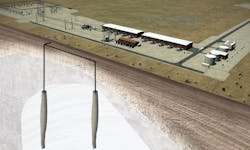Grid technology firm Dynapower joining infrastructure effort supporting Hydrogen ACES project
The Advanced Clean Energy Storage Hub currently under development in Delta, Utah, may be the biggest and most monumental implementation of hydrogen in the utility-scale energy mix to date, once it begins rolling into action over this decade.
The ACES will combine 220 MW worth of alkaline electrolyzer capacity with storage from massive salt caverns to store the hydrogen produced. Then that H2 will be deployed as a carbon-free fuel for the gas-fired turbines at the Intermountain Power Agency’s generation plant, ultimately converted to electricity for major markets in the western U.S.
In addition to the Intermountain utility, major players in the ACES project include Mitsubishi Power, Magnum Development, Black & Veatch (as engineering and construction leader) and WSP USA.
The latest firm contracted to participate in the historic project is power electronics supplier Dynapower. The latter was selected to deliver its IGBT chopper rectifier technology for high frequency switching technology.
“We’re thrilled to support this project and expand the use of clean hydrogen to decarbonize the energy ecosystem,” said Adam M. Knudsen, Chief Executive Officer of Dynapower. “Our commitment to advancing a clean energy future is stronger than ever, and we’re honored to be able to contribute our expertise to a renewables project of this size and magnitude, paving the way for the future of green hydrogen power and a cleaner planet.”
The IGBT chopper technology was selected for this project as it has a high power factor across the input range, a lower-cost transformer design, compliance with IEEE 519 grid harmonics, low DC ripple and quick response time to power generation changes – all supporting the intermittent supply of renewable energy, according to Dynapower.
Hydrogen does not contain a carbon atom in its chain, so does not emit carbon dioxide when combusted. To be qualified as truly "green hydrogen," however, it must be produced by electrolyzers powered by clean energy resources such as wind, solar, hydropower or nuclear energy.
Testing is under way to eventually increase the mix of hydrogen into the gas-fired turbines. Intermountain Power Agency plans to have a 30-percent mix operational to supply 840 MW of electricity capacity by 2025. The ultimate goal is to raise that H2 percentage to 100% in coming decades, once challenges to turbine performance are overcome.
-- -- --
(Rod Walton, senior editor for EnergyTech, is a 14-year veteran of covering the energy industry both as a newspaper and trade journalist. He can be reached at [email protected]).
Follow us on Twitter @EnergyTechNews and @rodwaltonelp and on LinkedIn
About the Author
Rod Walton, EnergyTech Managing Editor
Managing Editor
For EnergyTech editorial inquiries, please contact Managing Editor Rod Walton at [email protected].
Rod Walton has spent 17 years covering the energy industry as a newspaper and trade journalist. He formerly was energy writer and business editor at the Tulsa World. Later, he spent six years covering the electricity power sector for Pennwell and Clarion Events. He joined Endeavor and EnergyTech in November 2021.
Walton earned his Bachelors degree in journalism from the University of Oklahoma. His career stops include the Moore American, Bartlesville Examiner-Enterprise, Wagoner Tribune and Tulsa World.
EnergyTech is focused on the mission critical and large-scale energy users and their sustainability and resiliency goals. These include the commercial and industrial sectors, as well as the military, universities, data centers and microgrids. The C&I sectors together account for close to 30 percent of greenhouse gas emissions in the U.S.
He was named Managing Editor for Microgrid Knowledge and EnergyTech starting July 1, 2023
Many large-scale energy users such as Fortune 500 companies, and mission-critical users such as military bases, universities, healthcare facilities, public safety and data centers, shifting their energy priorities to reach net-zero carbon goals within the coming decades. These include plans for renewable energy power purchase agreements, but also on-site resiliency projects such as microgrids, combined heat and power, rooftop solar, energy storage, digitalization and building efficiency upgrades.

